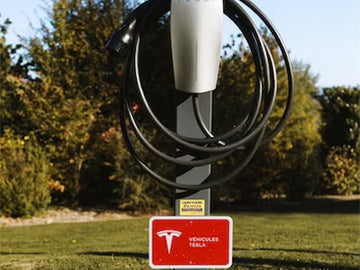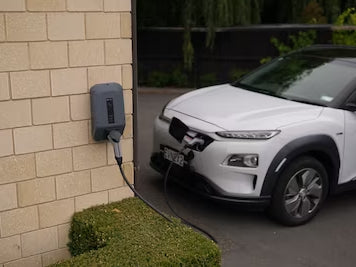
Tesla Destination Chargers play an essential role in the EV charging network, strategically placed at hotels, restaurants, and various public venues. These stations are designed primarily for Tesla vehicles but can also accommodate non-Tesla EVs in some cases. A key aspect of understanding their impact lies in the charging speed, which determines how effectively they meet the demands of on-the-go charging. Exploring their capabilities offers valuable insights into their efficiency and practicality, helping electric vehicle users make informed decisions and highlighting their significance in promoting sustainable transportation.
Tesla Destination Charger Charging Speed
Understanding the charging speed of Tesla Destination Chargers is crucial for electric vehicle (EV) enthusiasts seeking efficient charging solutions. A key aspect of Tesla Destination Chargers is their classification as a level 2 EV charger, providing a versatile charging experience. These chargers typically deliver power at a rate of 16 to 80 amps, depending on the specific charging station and the connected vehicle's compatibility. In comparison to standard household outlets, Tesla Destination Chargers significantly accelerate the charging process, allowing users to replenish their EV's battery more rapidly.
When comparing the charging speeds of Tesla Destination Chargers with other options, such as standard household outlets or level 1 chargers, the difference is notable. While household outlets provide a limited charging rate, level 1 chargers offer a slight improvement. However, Tesla Destination Chargers, operating at level 2, outpace these alternatives significantly. The enhanced charging speed of Tesla Destination Chargers is a compelling feature for users seeking a faster and more convenient way to charge their electric vehicles, making them a preferred choice for on-the-go charging needs. In summary, understanding the level 2 charger classification of Tesla Destination Chargers unveils their superior charging capabilities, offering an efficient and practical solution for electric vehicle owners.

Factors Influencing Charging Speed at Tesla Destination Chargers
The charging speed at Tesla Destination Chargers is influenced by various factors, contributing to the overall efficiency and convenience of the charging process. One key determinant is the battery capacity of the electric vehicle (EV). Larger battery capacities typically result in longer charging times, as more energy is required to fill the battery. Additionally, the existing charge level of the EV plays a significant role. Starting a charging session with a nearly depleted battery allows for faster charging compared to when the battery is already partially charged.
The classification of Tesla Destination Chargers as a level 2 EV charger also plays a crucial role in determining charging speed. Operating at a power range of 16 to 80 amps, these chargers significantly outpace standard household outlets and level 1 chargers. This distinction is particularly noteworthy when considering the context of home charging. While Tesla Destination Chargers offer rapid charging at public locations, users may also explore the option of having the fastest home EV charger installed. Home charging stations, often operating at the same level 2 capacity, allow users to enjoy the same expedited charging speeds in the convenience of their homes.
Another factor influencing charging speed is the presence of advanced charging technologies. Tesla's proprietary charging technology, including features like Supercharger compatibility for some Tesla vehicles, can further enhance charging speeds. For example, Tesla vehicles equipped with Supercharger V3 technology can achieve incredibly fast charging rates, significantly reducing the time required to replenish the battery.
User Experiences with Tesla Destination Chargers
Real-world charging experiences with Tesla Destination Chargers provide valuable insights into the practical aspects of utilizing these charging stations. Users often find Tesla Destination Chargers to be reliable and convenient for topping up their electric vehicle (EV) batteries during various scenarios. One common scenario is the utilization of these chargers during shorter stops, such as during meals at restaurants or while staying at hotels. Users appreciate the flexibility these charging stations offer, allowing them to seamlessly integrate charging into their daily routines without causing significant disruptions.
Moreover, Tesla Destination Chargers become particularly advantageous during travel, where users can plan their routes around locations equipped with these chargers. The strategic placement of Tesla Destination Chargers at hotels and other amenities enhances the overall travel experience, providing a convenient solution for charging without requiring dedicated stops at traditional gas stations. This convenience is further amplified by the growing network of Destination Chargers, contributing to an expanding and interconnected charging infrastructure.
Charging times at Tesla Destination Chargers are influenced by several factors, as showcased in real-world experiences. Users often report varying charging speeds based on factors like the existing charge level of their EVs and the specific capabilities of the charging station. For example, a user with a nearly depleted battery may experience faster charging compared to someone with a partially charged battery. Additionally, advancements in Tesla's proprietary charging technologies, such as Supercharger V3 compatibility for certain Tesla vehicles, can significantly reduce charging times, offering users a faster and more efficient charging experience.
In essence, real-world charging experiences with Tesla Destination Chargers highlight their practical utility and seamless integration into users' lifestyles. These charging stations play a pivotal role in shaping the narrative around electric vehicle adoption, emphasizing convenience and accessibility. As the network of Destination Chargers continues to expand, users can expect increasingly positive and efficient charging experiences, contributing to the broader transition towards sustainable and electric mobility.

Tesla Destination Charger vs. Supercharger
Differentiating between Tesla Destination Chargers and Superchargers involves understanding their distinct charging speeds and optimal use cases. While both serve the purpose of charging Tesla electric vehicles, they cater to different needs. Tesla Superchargers are designed for rapid charging, offering high power levels and significantly reducing charging times. Superchargers are best suited for long-distance travel or situations where users require a quick recharge to continue their journey promptly. On the other hand, Tesla Destination Chargers, being level 2 chargers not J1772 standard, provide a slower yet still efficient charging experience. They are strategically placed at destinations like hotels and restaurants for more extended stays, offering users the convenience of charging their vehicles while engaged in activities. The choice between Destination Chargers and Superchargers depends on the specific requirements of the user—whether it's a quick charge for a long journey or a more relaxed charge during a more extended stop. Tesla's comprehensive charging infrastructure ensures that users have the flexibility to choose the option that aligns best with their travel plans and charging needs.
Optimizing Charging Speed at Tesla Destination Chargers
To optimize charging speed at Tesla Destination Chargers, users can employ several tips and strategies to enhance overall efficiency. First and foremost, users should plan their charging sessions strategically. Initiating a charging session with a lower existing charge level allows for faster replenishment of the battery. Additionally, utilizing Tesla's mobile app or in-car navigation system to locate and select Tesla Destination Charger with fewer user can minimize wait times and maximize charging speed. Choosing locations with multiple Destination Chargers further improves the chances of finding an available charging spot.
Users can also leverage advanced features like scheduled charging through the Tesla mobile app. This allows them to set specific times for charging when electricity rates may be lower or when they are not actively using their vehicle, optimizing both cost and efficiency. Furthermore, Tesla owners may consider investing in a home charging solution, such as the fastest home EV charger, to supplement their charging needs. This ensures a consistently charged vehicle and reduces reliance on external charging infrastructure.
Future Developments in Charging Speed of Tesla Destination Charger
The future of charging speed at Tesla Destination Chargers holds promising advancements as electric vehicle (EV) technology continues to evolve. One potential development lies in the enhancement of charging infrastructure, with improvements aimed at increasing charging speeds. The integration of higher power levels and more efficient charging protocols may become standard, offering users even faster replenishment of their EV batteries. Additionally, advancements in battery technology can play a pivotal role in shaping the future of charging speed. As battery capacities increase and charging efficiency improves, the overall time required for charging at Tesla Destination Chargers is likely to decrease.
Furthermore, the ongoing research and development in wireless charging technology may present a revolutionary shift in how users interact with charging infrastructure. Wireless charging capabilities, once widely implemented, could eliminate the need for physical connectors, providing a seamless and convenient charging experience. Tesla's commitment to innovation suggests that future improvements in charging speed will align with the company's mission to make electric mobility more accessible and practical.
As the electric vehicle landscape evolves, collaborations between automakers, charging network providers, and technology companies may lead to standardized charging solutions. This could result in a more uniform and efficient charging experience across various EV models and charging networks. Ultimately, the future developments in charging speed at Tesla Destination Chargers are likely to focus on making electric vehicle ownership increasingly convenient, reducing charging times, and further encouraging the widespread adoption of sustainable transportation.

Tesla Destination Charger Speed and Future Innovations
Lastly, Tesla Destination Chargers, as Level 2 EV chargers, provide an efficient and adaptable charging option for electric vehicle owners. With charging speeds ranging from 16 to 80 amps, they offer a significant improvement over standard household outlets and Level 1 chargers, ensuring quicker and more reliable charging. User experiences show their convenience during short stops and longer stays, contributing to the expanding EV charging infrastructure. While slower than Tesla Superchargers, they remain practical for extended visits. Optimizing charging involves careful planning, using advanced features, and considering alternatives like faster home EVSE chargers. As charging technology advances and infrastructure improves, Tesla Destination Chargers will continue to evolve, paving the way for more accessible and efficient charging, supporting the broader transition to sustainable transportation.


